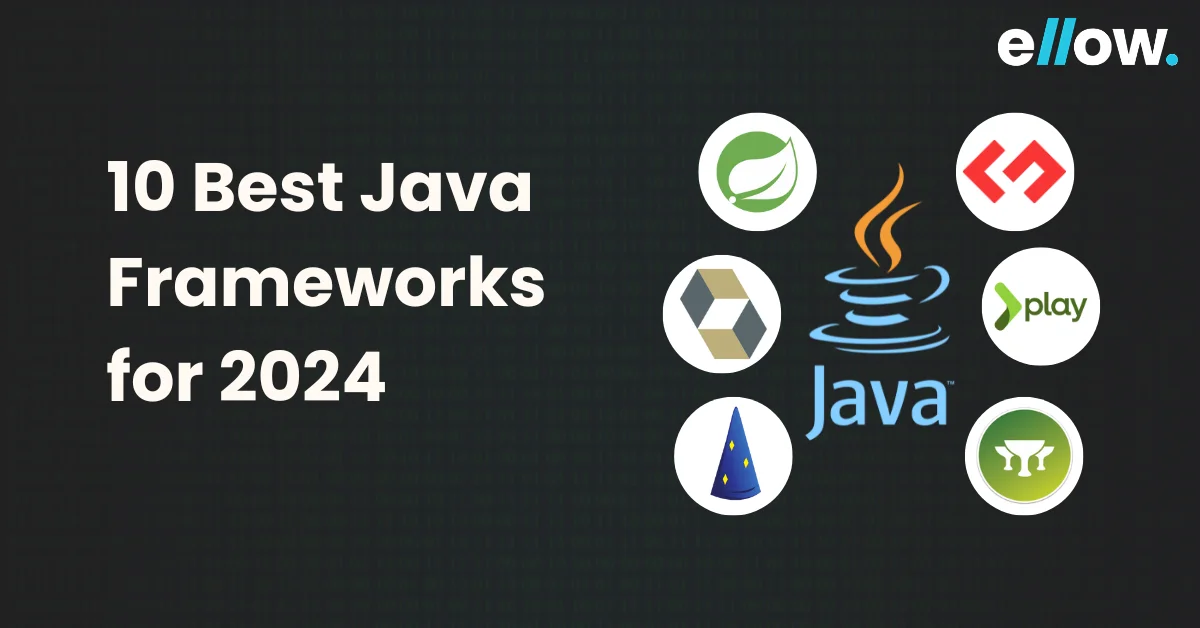Let’s build the future together.
Great ideas need great people. Partner with us to bring your vision to life, or take the first step in your career by joining our team of innovators.

A collection of predefined code used by developers to create web apps is called a Java framework. In the era of Java programming, Java frameworks have functions and classes that manage systems, handle input, and support communication with apps.
Importantly, Java frameworks have pre-existing libraries and codes enabling Java developers to develop apps without writing every piece of code from the beginning.
However, picking the relevant Java framework might be a tiresome task. Not to worry, we’ve got your back! In this piece of content, we will explore some top Java frameworks used for performant web development.
Before diving into the main focus of learning about the top Java frameworks, let’s understand what a Java framework is.
Java is a programming platform used by developers to develop the backend of any website or system. To make this development process easier, developers generally use Java frameworks.
These frameworks help in managing the data, organizing it, and ensuring that the client side of the website works accurately. Client-side can be handled using backend technologies as well.
So, when you choose a particular Java framework remember that it is a collection of predefined codes that is used by programmers to build apps on the web. These Java development platforms are also known as APIs (Application Programming Interfaces) or libraries.
They can seamlessly handle core hardware, input, and much more. A top-notch Java development company always prefers to use Java frameworks to build the app without writing every function’s code individually. Now, let’s explore the 10 best Java frameworks for 2024 and the upcoming years.
Let’s explore the list of top Java frameworks for your next Java project.
Spring is a Java web development framework that is open-source and also lightweight. It provides infrastructure support to make Java apps easily. It’s one of the top JEE (Java Enterprise Edition) tools that help programmers make high-performing apps using traditional Java objects.
Here are the best features of Spring:
Top benefits of using Spring framework for Java development:
Hibernate is not just another ORM (Object Relational Mapper). It is a game-changer for managing database operations in Java programming. Imagine writing minimum code but performing more, it is possible using Hibernate.
It can transform complex database queries into simple, and OOP (Object-oriented programming). For instance, if you are working with Java objects, Hibernate easily maps them in database tables. No more working on long SQL queries and DB intricacies.
The HQL- Hibernate Query Language lets you write database-independent queries in an OOP fashion.
Here are the best features of Hibernate:
Top benefits of using the Hibernate framework for Java development:
The name itself makes it look like one of the most reliable Java development frameworks. Similar to Spring and other Java frameworks, GWT is among the leading choices for building web user interfaces in Java. With its strong open-source community, GWT supports the creation of multiple applications
This framework is easy to integrate and is extremely lightweight.
Here are the best features of Google Web Toolkit:
Top benefits of using GWT framework for Java development:
Struts is one of the top frameworks for Java development based on different technologies like JSP, JSTL, XML, and much more. This framework provides an implementation of the MVC (Model View Controller) structure as a Java framework and provides a ready-to-use framework.
This framework lies in its M (model) layer, and it can be integrated with different Java frameworks like Spring, JDBC, Hibernate, etc.
Here are the best features of Struts:
Top benefits of using Struts framework for Java development:
Play is a Java framework designed specifically for Java development. It is an open-source tool that is known for its resilience. It is highly customizable to suit different project needs. Play is particularly well-regarded for creating REST APIs in Java and is considered one of the top choices for this purpose
It offers type-safe RESTful Web services using Scala. This framework has important components like an app server, a web server, and a web profiler.
Using Scala programming language, you can importantly contribute to the improved efficiency of the development cycle.
Here are the best features of Play:
Top benefits of using Play framework for Java development:
Dropwizard is an open-source Java framework that facilitates the building of RESTful services. It heavily relies on Hibernate, which offers robust object database functionality.
Dropwizard can establish safe communication between the database and app by using the client API for DB access.
Here are the best features of Dropwizard:
Top benefits of using the Dropwizard framework for Java development:
Grails framework is one of the top open-source frameworks in Java programming. It allows you to make dynamic web apps using Groovy, Java, and SQL. Its strong framework helps you to develop dynamic apps and websites quickly with minimal effort using the groovy language. It is mainly used for developing enterprise apps, mobile applications, and interactive websites.
Here are the best features of Grails:
Top benefits of using Grails framework for Java development:
Vaadin is a Java framework that is one of the best open-source Java structures for web development. Vaadin enables the development of advanced web applications with rich features that work seamlessly across different platforms. Written in Java, it ensures compatibility across various operating systems, making it versatile and accessible for developers across different environments.
It uses Swing components of Java to build web apps and provides a UI builder that lets designers make UI layouts.
Here are the best features of the Vaadin framework:
Top benefits of using the Vaadin framework for Java development:
Apache Wicket is a Java web app framework that has a component-based structure. It allows the developers to develop dynamic, interactive web apps using plain HTML and Java.
It integrates ease of use and simplicity, making it a better choice for developers, who want to develop a clear separation between logic and markup, without rearranging extensive XML config files.
Here are the best features of Apache Wicket:
Top benefits of using Apache Wicket framework for Java development:
JSF is an acronym of JavaServer Faces, which is an open-source fast-paced technology that helps you to make rich UI using Java. It’s one of the top Java web UI frameworks with components for designing interactive UIs.
Here are the best features of JavaServer Faces:
Top benefits of using the JSF framework for Java development:
So, these are the 10 best Java frameworks that you can utilize in 2024. Whether you’re aiming to secure a Java developer position or simply looking to broaden your knowledge in the field, understanding these frameworks puts you a step ahead of your competitors.
We hope this article has provided you with a comprehensive overview of Java frameworks, enabling you to confidently address primary queries related to what a Java framework is.
As you continue to explore and master Java frameworks, remember that practical implementation is key.
At Ellow, we specialize in connecting you with top-tier Java developers ready to bring your projects to life.
Whether you’re looking to implement the latest Java frameworks or require custom Java development services, our team is here to help.
Hire Java developers from Ellow today and elevate your software development projects to new heights.

How Top SaaS Companies Build Agile Teams with Remote Developers

How to Hire Vetted Remote Developers in a Hyper-Competitive Market

Top 5 Countries to Hire Remote Developers (and Why)
Please feel free to share your thoughts and we can discuss it over a cup of tea.
Get a quote
How Top SaaS Companies Build Agile Teams with Remote Developers

Six Things to Consider When Hiring Remote Talent

ellow.io enters remote hires market with AI-based screening process